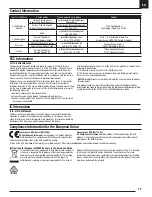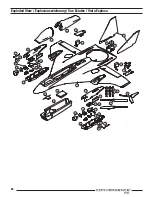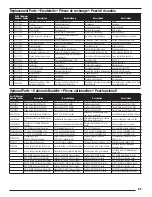
EN
11
Post Flight
1. Disconnect the fl ight battery from the fl ight controller
(Required for Safety and battery life).
2. Power OFF the transmitter.
3. Remove the fl ight battery from the aircraft.
4. Recharge the fl ight battery.
5. Repair or replace all damaged parts.
6. Store the fl ight battery apart from the aircraft and monitor the battery charge.
7. Make note of the fl ight conditions and fl ight plan results, planning for
future fl ights.
CAUTION:
Always disconnect the fl ight battery before performing
motor service.
Main Motor Removal
1. Pull the base of the rubber motor wire boot out of the nacelle slot.
2. Disconnect the motor wires from the ESC.
3. Remove the spinner nut from the collet shaft.
4. Remove the propeller, collet backplate and collet from the motor shaft.
5. Loosen both set screws on the motor mount.
6. Pull the motor from the motor mount.
Assembly is the reverse of the removal process.
Motor Service
Tail Motor Removal
1. Slide the wire clip fully to the rear of the tailboom.
2. Disconnect the tail motor wires from the ESC.
3. Remove the spinner nut from the collet shaft.
4. Remove the propeller, collet backplate and collet from the motor shaft.
5. Remove 3 screws from the tail motor mount and remove the left half of the
motor mount.
6. Remove the tail motor from the mount and carefully remove the motor
wires from the plastic wire clip.
Assembly is the reverse of the removal process.
Familiarize yourself with the
Flying Your Aircraft
section prior to trimming your
aircraft. Trimming should be done in calm wind conditions and with a fully
charged transmitter and fl ight battery.
1. During your fi rst Airplane Flight, trim the aircraft for level fl ight at
approximately 3/4 throttle.
2. Make small trim adjustments with your transmitter’s trim switches to
straighten the aircraft’s fl ight path.
3. When the aircraft maintains straight and level fl ight, land the aircraft in
multi-rotor mode.
4. Set the fl ight mode back to airplane mode. Take note of the neutral postion
of the control surfaces.
5. Adjust the control linkages mechanically to compensate for the amount of
trim entered.
6. Re-center the trims on the transmitter.
The transmitter trims should
always be centered for best fl ight performance.
7. Fly the aircraft again to check the changes made.
8. Repeat the trimming process until the aircraft will maintain reasonable
straight and level forward fl ight.
When the initial trimming process is done, the aircraft should not require
large amounts of trimming on subsequent fl ights. If large amounts of trim are
needed to hold straight and level fl ight on later fl ights, land the aircraft and
check the control surfaces for damage or binding.
In Flight Trimming






































